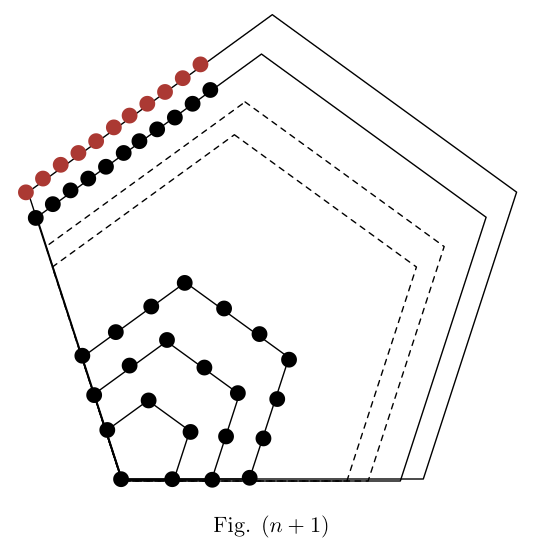Pentagonal Numbers - Generalized Step
 Going from the
n
th to the
(
n
+
1
)
th figure, how many more dots will we add?
Going from the
n
th to the
(
n
+
1
)
th figure, how many more dots will we add?
This section requires Javascript.
You are seeing this because something didn't load right. We suggest you, (a) try
refreshing the page, (b) enabling javascript if it is disabled on your browser and,
finally, (c)
loading the
non-javascript version of this page
. We're sorry about the hassle.
5 solutions
3n+1 is the correct answer if you count up from n=0. 3n-2 is the correct answer if you count up from n=1.
The general formula for the number of dots in the n th pentagonal number is 2 3 n 2 − n .
So the answer to the problem would be
no. of dots in n + 1 th number - no. of dots in n th number = 2 3 ( n + 1 ) 2 − ( n + 1 ) − 2 3 n 2 − n . = 3 n + 1
You're jumping the gun here. The idea is to work up to showing the general formula, which we can get at by knowing the difference in the number of dots.
Log in to reply
The no.of extra dits frm n to n+1will always be 3 right???
Use arithmetic progressions to find out nth and (n+1)th term. Then take the difference.
If n>=1 is the lenght of the side of the biggest pentagon in the figure, you always sum 3n +1 to the number of dots from the previous figure.
No of dots follows series 1 5 12 22 ? ...so next num will be 35 as dif between consecutive num follows sequence 4(5-1) 7(12-5) 10(22-12) 13(35-22)....so on which follows a sequence in GP a+(n-1)d=4+(n-1)3=3n+1...so num of dots increased in next fig is nothing but difference which is equal to 3n+1
The formula for the number of dots that will be added to the nth figure is 3 n − 2 (from the earlier problem "Pentagonal Numbers - How To Proceed?"). Substituting n with n + 1 , we get 3 ( n + 1 ) − 2 ⇒ 3 n + 3 − 2 ⇒ 3 n + 1